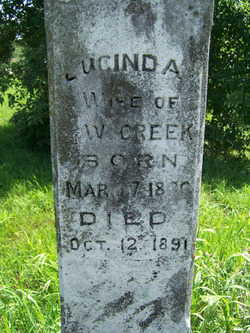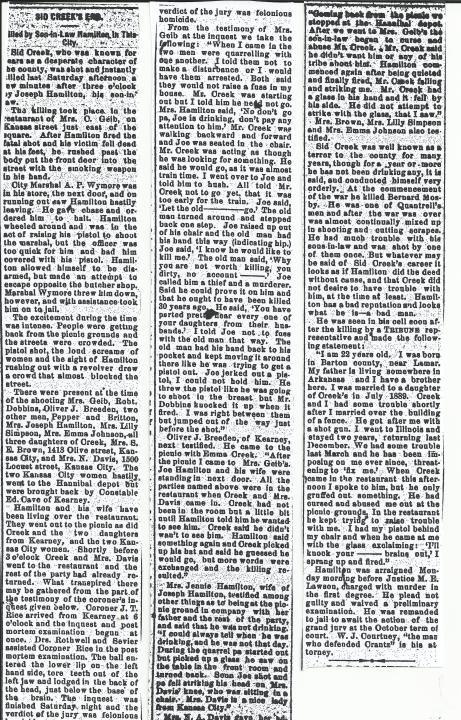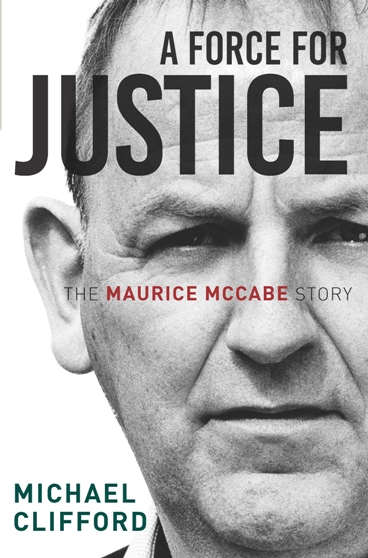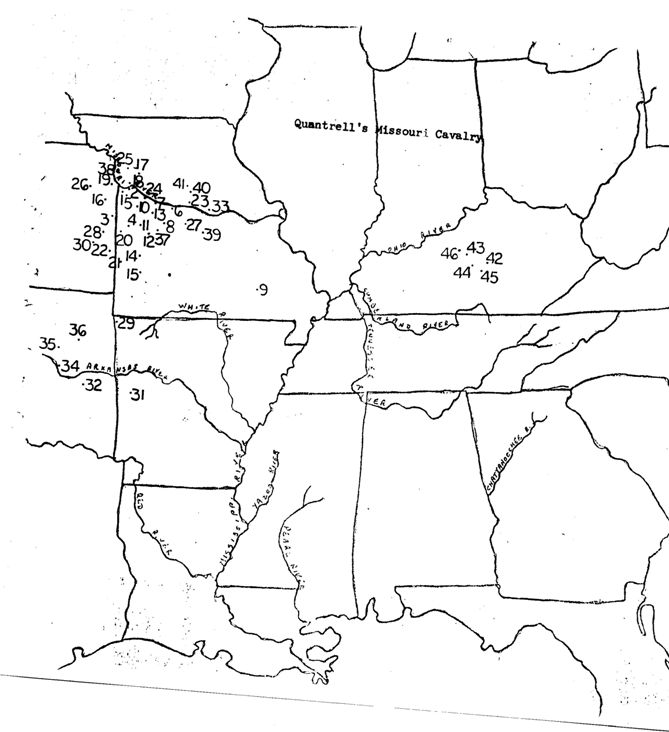In 1994, my cousin Dianne Honstein
ordered materials to assist her in researching our shared family
history, particularly as it had to do with the Civil War. One of the
published works she reviewed was entitled “Capsule History of
Quantrell’s Missouri Cavalry” written by John F. Walters. (This Capsule
History follows her letter below) Upon receipt she was dismayed by what
she read. Actually, she tells the story best. Thus, with her
permission, I shall transcribe her letter to Mr. Walters in its
entirety:
(Written from Ft. Morgan, Colorado, on 21 January 1994 by Dianne Honstein)
Dear Mr. Walter (sic),
Today I received your “Capsule History of Quantrell’s
Missouri Cavalry”. Thank you for your prompt reply. As I can see, the
roster that would be of greatest interest to me should be included in an
“Official History”, which I would like to order.
It is a fact that the winners write the history books. I
noted that your data came “by examining Federal sources only.” I really
had not anticipated this obvious bias in what should have been an
objective history. Please hear me out, as I can see that you are rightly
proud of your knowledge, and I do not wish to offend you.
I was born and raised in LA, with no knowledge of my
father’s ancestry. I had a vague assurance growing up that in the Civil
War the North was right and just, and the South was bad, and therefore,
they lost. In about 1984, when I was 38, my Dad challenged my sister
and me to find out something of his history. What he knew of it he never
told us, though he had lived with his grandmother Emma Reynolds. She
remembered many things from the 1860’s, including seeing Lincoln ride
through town on horseback when she was a child. (The same Lincoln who
conducted opinion polls on slavery before he announced a stand.) I know
that she told him family remembrances, but even after we showed him
extensive, documented findings back to the 1500’s, he did not tell us
what he knew. The amazing fact I learned from his not sharing his
knowledge of his history with us is that one hundred and thirty years
later, the prejudice against the South and the shame of losing lingers
on.
Suddenly I had a Confederate history. I decided I needed
to do some research and see what kind of people my people had been.
They were Lees, Youngers, Purcells, Reynolds, Creeks,
Daltons, and Estes’s. They were legislators, governors, farmers, and
businessmen. They had a history in this country from the North Eastern
shore of the Chesapeake in the 1600’s, where court was even held in
their ancestor’s home. Letters written by, and documents signed by,
family members are today in our government’s archives. Their Grandfather
Joshua Younger fought in the Revolution and went with Lewis and Clarke.
He had a Kentucky land grant signed by George Washington. Their father
fought beside Daniel Boon. (sic) They were of the wealthiest families in
Missouri, having bred, raised, trained and raced the finest horses in
the country. This yielded also a wealth of Southern principles and
social graciousness. They were of well educated and historically
prominent ancestry. They were Southern gentlemen.
So what happened? Because of their social prominence,
they got a great deal of media attention, of which the Union version
survived, and the Confederate view suffocated.
The Jayhawkers, or Redlegs, were vicious and
unprincipled. They were the first to raid along the Kansas-Missouri
border. Quantrill, a teacher, was traveling with his brother from
Maryland to California. The young men were camped for the night at
Cottonwood, KS, when a group of Jayhawkers attacked them and murdered
Quantrill’s brother, and severely wounded him. They stole everything and
left Quantrill to slowly die next to his brother in the woods. Three
days later, an Indian found Quantrill, buried his brother, took him to
his home, and cared for him. After a six month recovery, Quantrill took a
teaching position in a local school, and paid the Indian for his care.
He then went to Lawrence.
The unit that had attacked Quantrill and murdered his
brother was there, a part of the regiment under Col. Jim Lane. This was
about in 1857 – 1858. Quantrill joined this Union group as Charles Hart,
a scout. For approximately three years he sought out and somehow
assured the death of all but two of the men who had murdered his
brother. This done, he left the Lane regiment. I’m enclosing a couple of
pages from the book Quantrell and His Guerilla Band.
The Creeks, Youngers, and Daltons were cousins. This was
their “home turf” that the Jayhawkers were raiding. Quantrill was a
commissioned officer in the area by this time, and they joined him to
create a Confederate Cavalry unit. In their battles, they were proud,
even vain, of their courtesy to women, and of their consideration of the
old men. They did not ‘murder and rape’, but fought an invading army,
and bands of raiders, in order to protect their homes, families and
friends. In what I have read, the Jayhawkers were cruel and merciless
from the beginning, molesting and threatening the women, and frequently
hanging the old men. Retaliation was in order.
The Federal Union troops burned them out of their homes;
confiscated their land, imprisoned their mothers and sisters, murdered
their fathers by ambush, and disenfranchised them, as well as anyone who
gave them shelter or aid. They could no longer even support themselves.
The Federal government had taken all that they had. In turn, they took
it back. They weren’t robbing stores or homes. They weren’t highwaymen.
They robbed Federal banks, and trains carrying Federal monies,
retrieving that which was ‘stolen’ from them.
It was WAR, for Pete’s sake, and even back then, this was
a media event. I can understand the slant of the press at that time,
but you would think that after all this time and in our age of liberal
social justifications the labeling and the retelling of these stories
would have become, at the least, more objective. “Terrorized the
region”? “Carrying on”? “Frequent murders”? “Unauthorized raids”?
“Deserted his unit”? “Of the same type as their leader”?
You might see where this bias could be considered
offensive, and affect sales of your reports to those with ancestral
connections to the Confederacy.
But, as a surgical nurse, I think I can pare down the
‘halo-words’, the adjectives which totally deny the ideals, the
gentleness, the honor, the bravery and the devastation experienced and
passed down by my great-great Grandfather Sidney Washington Creek, and
gather from your text the information I am looking for. My analytical
training will allow me to do this, but my DNA has compelled me to take
this last hour-and-a-half to express my thoughts to you.
History is wonderful, isn’t it? It’s fascinating,
especially when you have personal ties to the past. We do share a common
interest. I do hope I haven’t offended you, and that when possible you
might consider reporting your histories from a broader source, or give a
thought to a more objective perspective. But I am glad and appreciative
to find someone like you who has taken the time and great effort to
compile our history so it is accessible, not lost or buried. I can’t
imagine the research and indexing you have done. I hope to get through
my recent find, a first edition of The Lost Cause: a New History of the
War of the Confederates, Edward Pollard, 1866. It’s hard to get through,
and is not indexed. But I will, I will. I do admire the work you are
doing.
Enclosed please find my check for $37.50 for an “Official History” of Quantrells Missouri Cavalry.
Thank you for your time.
Sincerely,
Dianne Creek Honstein
Transcript of letter written 21 Jan 1994, by Dianne Honstein
To John F. Walters in reprisal for his published work entitled “Quantrell’s Missouri Cavalry.”
Submitted by Melinda Cohenour with permission
Here is the info Diane Creek Honstein referenced as copied for clarity of reading from the PDF he sent her.
QUANTRELL'S MISSOURI CAVALRY
Without a doubt the most notorious band of men to see service
during the Civil War was the group known as Quantrell's Missouri
Cavalry. The unit
terroized large regions of Missouri and along the Kansas-Missouri border
for a great part of the War, carrying on - along with more strictly
military type operations and duties - frequent robberies, murders, and
unauthorized raids.
The unit, sometimes designated as a regiment but, in
actuallity only a battalion, fought under the Confederate flag for the
early part of its career. Later, bowever,
when its activities grew so far out of bounds, this protection offered
was withdrawn by Confederate authorities and the unit served in a
capacity not much above a group of outlaws.
William Clarke Quantrell, the unit's organizer and
commanding officer, had seen a great deal of service during the Kansas
Troubles of the late 1850's. When the War broke out he served in a small
cavalry company, taking part in the Battle of Wilson's Creek, Missouri,
in late summer of 1861. When this company disbanded Quantrell served
briefly as a private in a regular Missouri mounted regiment but soon
deserted and returned to the Blue Springs region of Missouri. There,
possibly because of a raid conducted by Kansas Jayhawkers on the home of
a friend, Quantrell decided to organize a unit to serve behind Federal
lines.
Sometime in late October, 1861, be was commissioned a
Captain in the Confederate Army. His band at this time numbered only
about fifty followers. No
official records exist to show that he was ever officially promoted over
the rank of Captain but he later often styled himself Major or Colonel.
By the time his band committed its most infamous act, the sack of
Lawrence, Kansas in August, 1863, the size of the group had risen to
more than four hundred and fifty men.
Included among these were men like "Bloody" Bill Anderson,
Arch Clements, and George Todd, all of whom would break with Quantrell
in the following months and lead bands of their own, each almost equally
notorious. Frank and Jesse James, Bob and Cole Younger, and others who
would, following the War, become infamous in their own rights as bank or
train robbers and killers, served with Quantrell. But, because so many
members of the group were of the same type as their leader, dissension
and dissatisfaction were frequent in the group and, by the end of the
war, when Quantrell had crossed the Mississippi River heading east with a
plan to kidnap or kill President Abraham Lincoln, fewer than thirty men
remained with him. Although the unit served side by side by regular
Confederate forces, even sometimes after it was no longer considered
part of the Confederate Army, no records have been found to indicate
that it was ever assigned to any specific higher command.
By examining Federal sources only, it would appear that
the unit took part in hundreds of Skirmishes, raids, etc. during the
War. So great was the fear
of the band that large numbers of events were laid at the doings of
Quantrell 's hand. While it is true that the group frequently served in
small detachments and saw service over a fairly large geographic area,
many engagements Federal sources
claim to have been fought against Quantrell were actually attributable
to other similar guerrilla organizations.
A careful examination of both official and unofficial
records show that Ouantrell' s Missouri Cavalry participated in more
than (missing words) various type
engagements. These are identified below. Numbers after the events locate
them on the map following this history.
Skirmish, Little Sante Fe, Mo.Nov. 21, 1861
Expedition to Blue Springs, Mo. (1)Jan. 29 - Feb. 3, 1862
Skirmish, Independence, Mo. (2)Feb. 18, 1862
Skirmish, Independence, Ho. (2)Feb. 22, 1862
Skirmish near Aubrey, Kan. (3) March 12, 1862
Skirmish, Little Sante Fe , (detachment)March 22, 1862
Skirmish, Post Oak Creek, Mo (4 ) (detachment )March 22, 1862
Skirmish, Independence , Mo. (2) (detachment )March 22, 1862
Skirmish, Gouge ' s Mill, Mo. March 26, 1862
Skirmish, Pink Hill, Mo. (detachment )March 31, l862
Skirmish, Little Sni, Mo. (detacnment )April 1, 1862
Skirmish, Little Blue River, Mo. (5)April 12, 1862
Skirmish, Santa Fe Road, Mo.April 14, 1862
Skirmish, Independence, Mo. (2)May 16, 1862
Operations about Miami (6 ) and Waverly (7), Mo. and
SkirmishesMay 25 - 28, 1862
Skirmish, Little Blue, Jackson County, Mo. (5)June 2, 1862
Skirmish near Sedalia, Mo. (8)June 5, 1862
Skirmish, Eminence, Mo. (9)June 17, 1862
Skirmish, Raytown, Mo. (10)June 23, 1862
Skirmish, Pleasant Hill, Mo. (11)July 8, 1862
Skirmish, Lot of Peach Farm on Sugar Creek near Wadesburg , Mo. (?)July 9, 1862
Skirmish , Clinton, Mo. (12 )July 9, 1862
Skirmishes, Search Big Creek Bluff near Pleasant Hill, Mo. (11)July 11, 1862
Skirmish , lake water near Columbus, Mo (13)July 23, 1862
Action, Independence, Mo. (2)Aug. 11, 1862
Operations against the Expedition to Hickory Grove, Mo.(14)Aug. 17 - 27' 1862
Skirmish, Hickory Grove, Mo. (14)Aug. 23, 1862.
Skirmish, Coon Creek near Lamar, Mo. (15)Aug. 24, 1862
Skirmish, Lamar, Mo. (15)Aug. 24, 1862
Raid, Olathe, Kan. (16)Sept. 6, 1862
Skirmish, Liberty (17 ) and Sibley's Landing (18), Mo.Oct. 6, 1862
Raid, Shawnee, Kan. (19)Oct. 17, 1862
Operations in Jackson County, Mo. (20) (detachment)Nov. 1 - 5, 1862
Skirmish, Harrisonville, Cass County, Mo. (21) (detachment)Nov. 3, 1862
Skirmish, Lamar, Mo. (16) (detachment)Nov. 5, 1862
Operations against the Expedition from Fort Scott, Kan.(22)Nov. 6 - 11, 1862
Skirmish, Cato, Kan. Nov. 8, 1862
Engagement, Cane Hill, Boston Mountains, Boonsboro, Mo. (23) (detachment)Nov. 28, 1862
Skirmish, Independence, Mo. (2)Feb. 3, 1863
Skirmish, Independence, Mo. (2)Feb. 8, 1863
Skirmish near Aubrey, Kan. (3)March 12, 1863
Skirmish, Blue Springs (1) near Independence (2), Mo.March 22, 1863
Skirmish, Independence, Mo. (2)April 23, 1863
Operations about Lexington, Mo. (24) (detachment)May 4, 1863
Skirmish, Big Creek near Pleasant Hill, Mo. (11)May 15, 1863
Skirmish, Richfield, Clay County, Mo. (25) (detachment)May 19, 1863
Skirmish, Subley, Mo. (18)June 23, 1863
Skirmish. Hudson's Ford, Neosho River, I. T. June 30, 1863
Skirmish, Lawrence, Kan. (26 ) (detachment )July 27, 1863
Skirmish, Saline County, Mo. (27) (detachment)July 31 , 1863
Skirmish, Taylor's Farm, Little Blue, Mo. (5)Aug. 1, 1863
Skirmish, Jack's Fork, Mo. (detachment)Aug. 14, 1863
Skirmish near Sherwood, Mo . (detachment)Aug. 14, 1863
Massacre, Lawrence, Kan. (26)Aug. 21, 1863
Skirmish, Brooklyn, Kan.Aug. 21, 1863
Skirmish, Paoli, Kan. (28 )Aug. 21, 1863
Quantrell's Raid into Kansas Aug. 21 - 28, 1863
Skirmish, Big Creek near Pleasant Hill, Mo. (11 ) (detachment)Aug. 22, 1863
Skirmish, Independence, Mo. (2)Aug. 25, 1863
Skirmishes near Hopewell, Mo. ( detachment )Aug. 25 - 26, 1863
Operations against the Scout from Coldwater Grove to
Pleasant Hill (11 ) and Big Creek, Mo . and SkirmishesSept. 4 - 7' 1863
Skirmish near Maysville, Ark . (29 ) (detachment )Sept. 5, 1863
Skirmish, Jackson County, Mo. (20) (detachment)Sept. 15, 1863
Skirmish, near Widow Wheeler's, Mo.Oct. 4, 1863
Action, Baxter Springs, Kan. (30)Oct. 6, 1863
Skirmish, Fort Blair, Waldron, Ark. (31) (detachment)Oct. 6, 1863
Skirmish, Choctaw Nation, I. T. (32) (detachment )Oct. 7, 1863
Skirmish near Man's Creek, Mo. (detachment)Oct. 14, 1863
Affair, Greenton Valley near Hopewell (33) , Mo. (detachment)Oct. 21, 1863
Attack, Fort Gibson, I. T. (34 )Dec. 16, 1863
Skirmish near Sheldon Place, Barren Fork, I. T. (35)Dec . 18, 1863
Skirmish near Fort Gibson : I. T. (34 )Dec . 26, 1863
Operations in the Indian Territory April 15 - 20, 1864
Affair near Choshy, I. T. (36 )April 20, 1864
Skirmish, Dayton, Mo . (detachment )April 26, 1864
Skirmish, Ofatt ' s Knob , Mo . (detachment )April 28, 1864
Skirmishes, Johnson County, Mo. ( 37 ) (detachment )April 23 - 30, 1864
Skirmish, Sni Hills, Mo. (detachment)April 29, 1864
Skirmish near Arnoldsville and Raid on New Market (38), Mo. June 1, 1864
Affair·, Versailles, Mo. (39)July 13, 1864
Skirmish, Saline County, Mo. (27) (detachment)Aug 13, 1864
Skirmish, Fort Gibson, I. T. (34) (detachment)Sept. 10, 1864
Skirmish, Fayette, Mo. (40) (detachment)Sept. 24, 1864
Skirmish near Glasgow, Mo. (41) (detachment)Jan. 10, 1865
Affair, Danville, Ky. (42)Jan. 29, 1865
Skirmish, near Chaplintown, Ky. (43)Jan. 30, 1865
Affair, New Market, Ky.Feb. 8, 1865
Skirmish, Bradfordsville , Ky. (44)Feb. 3, 1865
Skirmish, Hustonville, Ky. (45)i eb. 9, 1865
Skirmish near Bloomfield, Ky. (46)April 13, 1865
Quantrell was seriously wounded at Bloomfield on April 13,
1865. Federal troops captured him and brought him to Louisville,
Kentucky. Here he claimed that his name was William Clarke (some
references will be found in official and unofficial sources to Clarke's
Kentucky Cavalry Company) but his identity was soon established. Upon
his capture the few remaining members of his band still at large
dispersed, some returning to Missouri and their illegal activities.
Quantrell's condition had, in the meantime, worsened and he died in
Louisville on June 4, 1865.
This concludes the Capsule History provided by John F. Walters (copied for clarity of reading from the PDF.)
Compiled and Presented by Melinda Cohenour.
Click on author's byline for bio and list of other works published by Pencil Stubs Online.




















